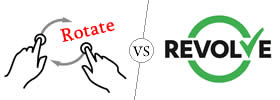Difference between ASP and HTML
Key difference: ASP stands for Active Server Pages. It is commonly known as Classic ASP or ASP Classic. It is a server-side scripting environment that is developed and released by Microsoft. ASP was superceded by ASP.NET. ASP.NET is a server-side Web application framework. ASPX stands for Active Server Pages Extended. It was designed for Web development to produce dynamic Web pages. HTML stands for HyperText Markup Language. It is a well known mark up language used to develop web pages. It has been around for a long time and is commonly used in webpage design.
 ASP stands for Active Server Pages. It is commonly known as Classic ASP or ASP Classic. It is a server-side scripting environment that is developed and released by Microsoft. It was Microsoft's first server-side script engine for dynamically generated web pages. ASP was originally released as part of the Windows NT 4.0 Option Pack. It was meant to be an add-on to Internet Information Services (IIS). Since, then ASP has been superseded by ASP.NET, another product by Microsoft.
ASP stands for Active Server Pages. It is commonly known as Classic ASP or ASP Classic. It is a server-side scripting environment that is developed and released by Microsoft. It was Microsoft's first server-side script engine for dynamically generated web pages. ASP was originally released as part of the Windows NT 4.0 Option Pack. It was meant to be an add-on to Internet Information Services (IIS). Since, then ASP has been superseded by ASP.NET, another product by Microsoft.
ASP is mainly used to create and run dynamic, interactive Web server applications. It also allows one to combine HTML pages, script commands, and COM components to create interactive Web pages and powerful Web-based applications. It also makes it easier to develop and modify the said Web applications.
After its original release, there have been two version releases. The ASP 2.0 introduced six built-in objects to the original, which were Application, ASPError, Request, Response, Server, and Session. ASP 3.0 introduced some additional enhancements such as Server.Transfer method, Server.Execute method, and an enhanced ASPError object. Additionally, ASP 3.0 also enabled buffering by default and optimized the engine for better performance. However, as of May 2013 there are no planned upgrades to ASP.
ASP was superseded by the ASP.NET. ASP.NET is a server-side Web application framework. ASPX stands for Active Server Pages Extended. It was designed for Web development to produce dynamic Web pages. It was released in January 2002 with the .NET Framework. It is mainly used to build dynamic web sites, web applications and web services.
ASP.NET is built on the Common Language Runtime (CLR). This allows programmers to write ASP.NET code using any supported .NET language. ASP.NET Web pages are also commonly known as Web Forms. They contain static (X)HTML markup. It also contains markup that defines server-side Web Controls and User Controls. This is where developers place all the rc content for the Web page.
In ASP.NET Framework 2.0, a new code-behind model was introduces. This allows static text to remain on the .aspx page, while dynamic code remains in an .aspx.vb or .aspx.cs or .aspx.fs file. The location of the dynamic code depends on the programming language used.
 HTML stands for HyperText Markup Language. It is a well known mark up language used to develop web pages. It has been around for a long time and is commonly used in webpage design. XML or Extensible Markup Language defines a set of rules for encoding documents in a format that can be read by both, human and computer.
HTML stands for HyperText Markup Language. It is a well known mark up language used to develop web pages. It has been around for a long time and is commonly used in webpage design. XML or Extensible Markup Language defines a set of rules for encoding documents in a format that can be read by both, human and computer.
HTML is written using HTML elements, which consist of tags, primarily and opening tag and a closing tag. The data between these tags is usually the content. The main objective of HTML is to allow web browsers to interpret and display the content written between the tags. The tags are designed to describe the page content. HTML comes with predefined tags. They allow one to insert images, text, videos, forms and other pieces of content together into a cohesive webpage.
Elements of HTML are the basic building blocks of all websites. HTML allows images and objects to be embedded in the webpage. It can also be used to create interactive forms. HTML also provides the means to create structured documents. It does this by denoting structural semantics for text such as headings, paragraphs, lists, links, quotes and other items. However these days, web pages are rarely designed using only HTML. HTML allows for the programmer to embed scripts written in languages such as JavaScript, which many often do. This changes the look and behavior of the HTML web pages.
Some differences between ASP and HTML:
- HTML is a client-side language, whereas ASP is a server-side language.
- ASP is used to design user-interactive pages or dynamic pages, whereas HTML is used to design static pages.
- ASP can use any scripting languages.
- ASP is used to embed programming and server side directives into an HTML web page.
- ASP.NET allows one to use and create reusable complex html controls, using programming languages.
- HTML page can not connect to the database, but ASP and ASP.NET Pages can.
- The content on an ASP.NET page is derived from a data source, such as a database.
Image Courtesy: johnwilliams92.info, teamtreehouse.com









Add new comment